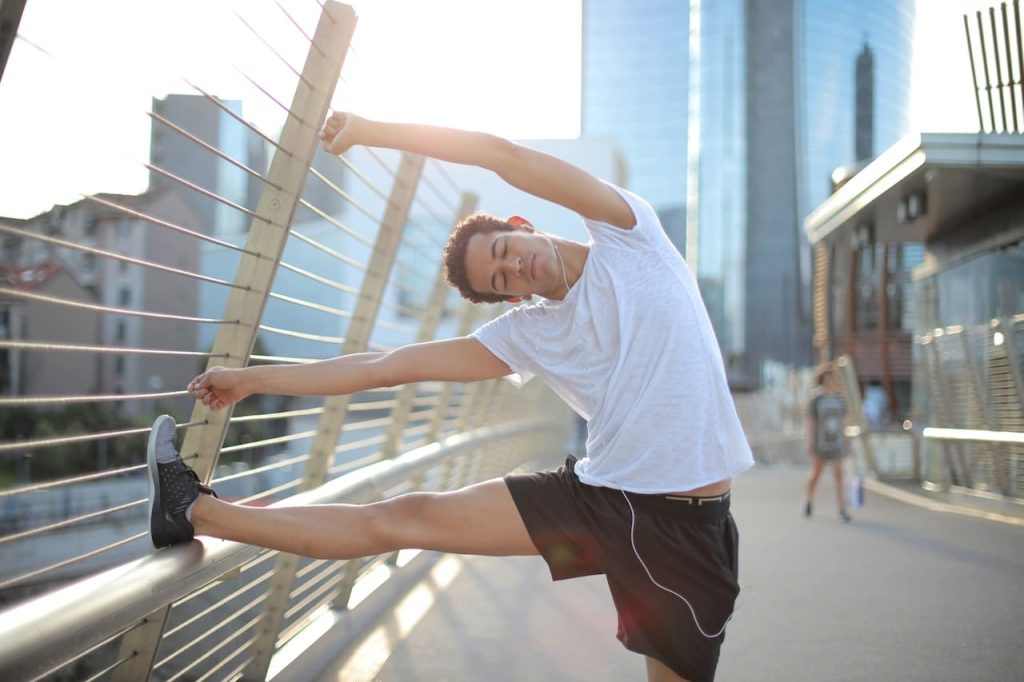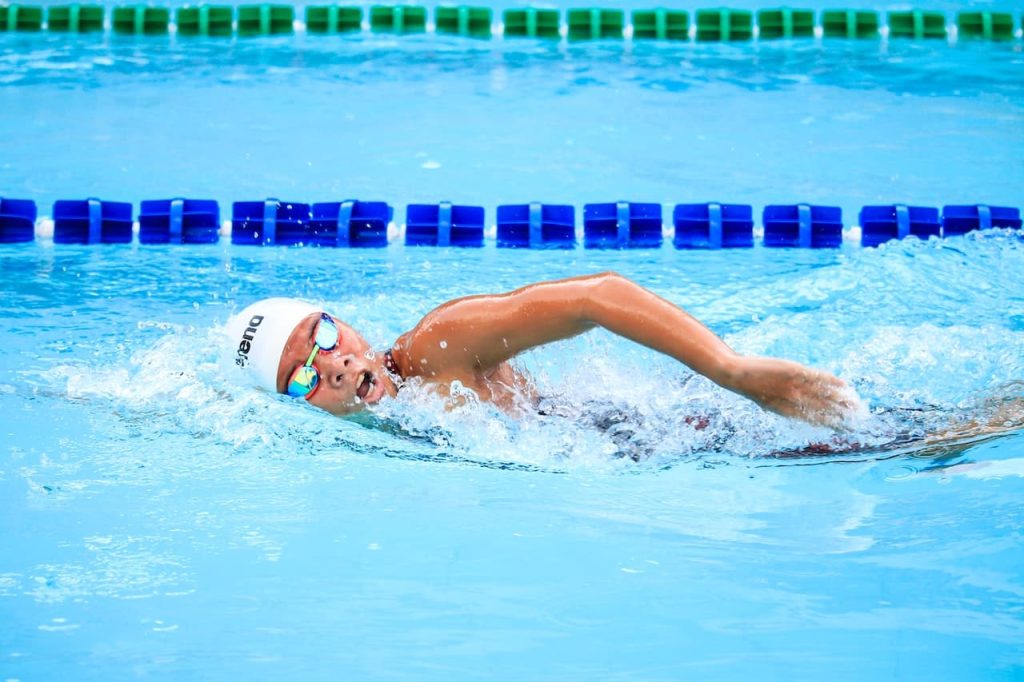
In der Welt des Sports ist die Bedeutung von Stretching und Flexibilitätstraining für die Verletzungsprävention und die Verbesserung der Leistungsfähigkeit nicht zu unterschätzen. Durch regelmäßiges Stretching können Sportler ihre Beweglichkeit verbessern, ihre Muskeln aufwärmen und ihre Gelenke auf Belastungen vorbereiten. In diesem Artikel werden wir die Vorteile des Stretchings und des Flexibilitätstrainings genauer betrachten und erklären, wie diese Praktiken Sportlern dabei helfen können, Verletzungen vorzubeugen und ihre sportliche Leistung zu steigern.
Die Grundlagen von Stretching
Stretching ist eine wichtige Komponente des Fitness- und Trainingsprogramms, die sowohl für Freizeitsportler als auch für professionelle Athleten von Bedeutung ist. Bevor wir uns jedoch mit den Vorteilen des Stretchings auseinandersetzen, ist es wichtig, die grundlegenden Arten des Stretchings zu verstehen: die statische Dehnung und die dynamische Dehnung.
Statische Dehnung

Die statische Dehnung ist eine Dehntechnik, bei der eine bestimmte Position erreicht und für einen längeren Zeitraum gehalten wird, normalerweise zwischen 15 und 60 Sekunden. Während der statischen Dehnung werden die Muskeln sanft gedehnt, ohne dass ruckartige Bewegungen oder Wiederholungen erforderlich sind. Diese Art des Stretchings ermöglicht es den Muskeln, sich zu entspannen und die Flexibilität im Laufe der Zeit zu verbessern.
Dynamische Dehnung
Im Gegensatz dazu beinhaltet die dynamische Dehnung Bewegungen durch den gesamten Bewegungsbereich einer bestimmten Muskelpartie. Bei der dynamischen Dehnung werden kontrollierte und fließende Bewegungen durchgeführt, die den Muskel in seiner natürlichen Funktion nachahmen. Dies umfasst oft eine Kombination aus Dehnen und aktiver Bewegung, um die Flexibilität zu verbessern und den Körper auf bevorstehende sportliche Aktivitäten vorzubereiten.
Beide Arten des Stretchings haben ihre eigenen Vorteile und können je nach individuellem Bedarf und Trainingsziel eingesetzt werden. Die statische Dehnung eignet sich besonders gut, um die Flexibilität langsam zu verbessern und die Muskeln zu entspannen. Sie kann am besten nach dem Training oder als eigenständige Stretching-Einheit durchgeführt werden. Die dynamische Dehnung hingegen ist ideal, um die Beweglichkeit und das Bewegungsmuster für bestimmte Sportarten oder Aktivitäten zu verbessern. Sie wird oft als Teil des Aufwärmens vor dem Training oder Wettkampf verwendet.
Unabhängig von der gewählten Methode ist es wichtig, beim Stretching auf seinen Körper zu hören und die Dehnungen kontrolliert und ohne Schmerzen auszuführen. Die Dehnungen sollten langsam und gleichmäßig sein, ohne ruckartige Bewegungen oder übermäßige Belastungen der Muskeln. Das Stretching sollte sich angenehm anfühlen und sollte nicht zu Schmerzen oder Verletzungen führen. Es ist ratsam, sich vor dem Stretching aufzuwärmen, um die Durchblutung zu steigern und die Muskeln auf die Dehnung vorzubereiten.
Das Verständnis der Grundlagen des Stretchings ist der erste Schritt, um die Vorteile dieser wichtigen Trainingskomponente voll auszuschöpfen. Sowohl die statische als auch die dynamische Dehnung tragen dazu bei, die Flexibilität zu verbessern, die Muskeln zu entspannen und den Körper auf sportliche Aktivitäten vorzubereiten. Indem man regelmäßig Stretching in sein Trainingsprogramm integriert, kann man die Beweglichkeit steigern, Verletzungen vorbeugen und die sportliche Leistungsfähigkeit verbessern.
Die Vorteile von Stretching
Stretching bietet eine Vielzahl von Vorteilen für Sportler aller Disziplinen. Hier sind einige der wichtigsten Vorteile, die regelmäßiges Stretching mit sich bringt:
Verbesserung der Körperhaltung

Stretching hilft dabei, muskuläre Ungleichgewichte auszugleichen und die Körperhaltung zu verbessern. Durch das Strecken verkürzter Muskeln und das Stärken schwächerer Muskeln wird eine ausgeglichene Muskelfunktion erreicht, was zu einer aufrechteren und gesünderen Körperhaltung führt.
Steigerung der sportlichen Leistung
Eine verbesserte Flexibilität und Beweglichkeit durch regelmäßiges Stretching ermöglichen eine bessere Ausführung von Bewegungen und Techniken in Sportarten. Durch einen größeren Bewegungsumfang können Sportler ihre Leistungsfähigkeit steigern und ihre Bewegungen effizienter gestalten.
Förderung der Muskelregeneration
Stretching nach dem Training oder an trainingsfreien Tagen kann dazu beitragen, die Muskelregeneration zu fördern. Es unterstützt den Abtransport von Stoffwechselabbauprodukten aus den Muskeln und fördert die Durchblutung, was zu einer schnelleren Erholung führen kann.
Stressabbau und Entspannung
Stretching hat auch eine positive Wirkung auf das psychische Wohlbefinden. Es kann Stress abbauen und für Entspannung sorgen. Durch die bewusste Ausführung der Dehnungen und die Konzentration auf den eigenen Körper wird eine erholsame und meditative Atmosphäre geschaffen.
Es ist wichtig, das Stretching richtig auszuführen und auf den eigenen Körper zu hören. Überdehnungen oder ruckartige Bewegungen sollten vermieden werden, um Verletzungen zu vermeiden. Stretching sollte immer in Verbindung mit einem angemessenen Aufwärmprogramm durchgeführt werden, um die Muskeln vorzubereiten und das Verletzungsrisiko weiter zu minimieren.
Indem man das Stretching regelmäßig in sein Trainingsprogramm integriert, kann man von all diesen Vorteilen profitieren. Eine gute Flexibilität unterstützt nicht nur die Verletzungsprävention, sondern auch die Leistungsfähigkeit und das allgemeine Wohlbefinden. Sowohl für Freizeitsportler als auch für professionelle Athleten ist Stretching eine wertvolle Ergänzung zu ihrem Training.
Flexibilitätstrainingstechniken
Es gibt verschiedene Techniken und Trainingsmethoden, um die Flexibilität zu verbessern. Hier sind drei beliebte Flexibilitätstrainingstechniken:
Yoga

Yoga kombiniert körperliche Übungen, Atmung und Meditation. Es fördert die Flexibilität, stärkt die Muskulatur und verbessert die Körperhaltung. Yoga kann sowohl als eigenständige Aktivität als auch als Ergänzung zu anderen Sportarten praktiziert werden.
Pilates
Pilates ist ein Ganzkörpertraining, das auf der Stärkung der Rumpfmuskulatur und der Verbesserung der Flexibilität basiert. Es kombiniert kontrollierte Bewegungen mit spezieller Atmung und fördert die Körperbalance und -stabilität.
Dehntechniken für Sportarten
Verschiedene Sportarten erfordern spezifische Dehntechniken, um die Muskeln auf die Bewegungen während des Trainings oder Wettkampfs vorzubereiten. Sportler sollten sich mit den geeigneten Dehnübungen für ihre jeweilige Sportart vertraut machen.
Stretching vor dem Training
Das Stretching vor dem Training ist von entscheidender Bedeutung, um den Körper auf die bevorstehende körperliche Aktivität vorzubereiten. Hier sind einige Vorteile des Stretchings vor dem Training:
Aufwärmen der Muskeln
Durch das Aufwärmen der Muskeln vor dem Training werden sie besser durchblutet und auf die bevorstehende Belastung vorbereitet. Dies reduziert das Verletzungsrisiko und verbessert die Leistungsfähigkeit.
Verbesserung der Bewegungsqualität
Stretching vor dem Training hilft dabei, den Bewegungsumfang zu verbessern. Dies ermöglicht es Sportlern, Bewegungen präziser und effizienter auszuführen, was zu einer besseren sportlichen Leistung führt.
Verletzungsprävention

Durch das Aufwärmen der Muskeln und das Durchführen von Stretchingübungen vor dem Training können Sportler Verletzungen wie Muskelzerrungen, Verstauchungen und Sehnenentzündungen vorbeugen.
Stretching und Flexibilitätstraining nach dem Training
Medizinische und sportwissenschaftliche Publikationen haben gezeigt, dass das Stretching nach dem Training mehrere positive Effekte auf die Muskelerholung hat. Eine Studie aus dem Journal of Strength and Conditioning Research fand heraus, dass das Stretching nach dem Training dazu beiträgt, den Anstieg der Muskelsteifheit zu reduzieren und die Muskelregeneration zu beschleunigen.
Darüber hinaus wurde in einer anderen Studie, veröffentlicht im Journal of Sports Sciences, festgestellt, dass das Stretching nach dem Training die Durchblutung in den gedehnten Muskeln erhöht. Dies führt zu einer verbesserten Sauerstoffversorgung und Nährstoffzufuhr, was die Reparatur und den Aufbau von Muskelgewebe unterstützt.
Ein weiterer wichtiger Aspekt des Stretchings nach dem Training ist die Förderung der Flexibilität. Während des Trainings werden die Muskeln oft stark beansprucht und können sich verkürzen. Durch das Stretching nach dem Training werden die Muskeln gedehnt und die Flexibilität verbessert. Dies hilft, muskuläre Ungleichgewichte auszugleichen und das Risiko von Verletzungen zu verringern.
Einige spezifische Dehnübungen, die nach dem Training durchgeführt werden können, umfassen das Dehnen der großen Muskelgruppen wie Oberschenkel, Waden, Hüften und Schultern. Statische Dehnungen, bei denen eine Position erreicht und für 15-60 Sekunden gehalten wird, sind oft am effektivsten für die Muskelentspannung und Verbesserung der Flexibilität.
Es ist jedoch wichtig zu beachten, dass das Stretching nach dem Training individuell angepasst werden sollte. Je nach Trainingsintensität und persönlicher Fitness kann die Dauer und Intensität des Stretchings variieren. Es ist ratsam, sich von einem qualifizierten Trainer oder Physiotherapeuten beraten zu lassen, um das Stretching-Programm entsprechend anzupassen.
Zusammenfassend lässt sich sagen, dass das Stretching nach dem Training zahlreiche Vorteile bietet. Es unterstützt die Muskelregeneration, reduziert Muskelkater, verbessert die Flexibilität und fördert die Durchblutung. Durch die Integration des Stretchings in das Training kann die Gesamtleistungsfähigkeit gesteigert und das Verletzungsrisiko verringert werden. Es ist jedoch wichtig, auf den eigenen Körper zu hören und das Stretching angemessen anzupassen, um maximale Ergebnisse zu erzielen.
Quellen:
- Herbert RD, de Noronha M, Kamper SJ. Stretching to prevent or reduce muscle soreness after exercise. Cochrane Database Syst Rev. 2011;(7):CD004577.
- Behm DG, Chaouachi A. A review of the acute effects of static and dynamic stretching on performance. Eur J Appl Physiol. 2011;111(11):2633-2651.
- Cramer JT, Housh TJ, Weir JP, Johnson GO, Coburn JW, Beck TW. The acute effects of static stretching on peak torque, mean power output, electromyography, and mechanomyography. Eur J Appl Physiol. 2005;93(5-6):530-539.
Die Rolle des Stretchings bei spezifischen Sportarten
Stretching spielt eine wichtige Rolle in verschiedenen Sportarten. Hier sind einige Beispiele, wie Stretching spezifischen Sportarten zugutekommen kann:
Laufen und Joggen
Stretching verbessert die Beweglichkeit der Beinmuskulatur und verringert das Verletzungsrisiko beim Laufen und Joggen. Es kann auch dazu beitragen, die Laufeffizienz zu verbessern und die Laufgeschwindigkeit zu steigern.
Krafttraining
Flexibilitätstraining ist auch für Kraftsportler wichtig. Durch Stretching können sie ihre Beweglichkeit verbessern und das Verletzungsrisiko verringern. Eine gute Flexibilität ermöglicht es ihnen auch, die volle Bewegungsamplitude bei Kraftübungen zu nutzen.
Schwimmen

Stretching ist für Schwimmer von Vorteil, da es die Beweglichkeit der Schulter- und Beinmuskulatur verbessert. Eine gute Flexibilität hilft Schwimmern, längere und effizientere Schwimmzüge auszuführen.
Fußball
Im Fußball ist Flexibilität wichtig, um Verletzungen zu vermeiden und die Leistungsfähigkeit zu steigern. Durch Stretching können Fußballspieler ihre Beweglichkeit verbessern, schneller sprinten und agiler auf dem Spielfeld sein.
Die Bedeutung der Progression im Stretching
Beim Stretching ist es wichtig, die Progression im Auge zu behalten. Hier sind einige Aspekte, die bei der Progression im Stretching berücksichtigt werden sollten:
Steigerung der Intensität und Dauer
Um die Flexibilität kontinuierlich zu verbessern, ist es wichtig, die Intensität und Dauer des Stretchings allmählich zu steigern. Dies kann durch längeres Halten der Dehnpositionen oder das Erreichen von größeren Bewegungsumfängen erreicht werden.
Vermeidung von Überdehnung
Es ist wichtig, beim Stretching Überdehnung zu vermeiden, da dies zu Verletzungen führen kann. Sportler sollten ihre Grenzen respektieren und sanft dehnen, ohne Schmerzen zu verursachen.
Die Progression im Stretching kann auch durch die Verwendung von Hilfsmitteln wie Stretching-Bändern oder -Blöcken unterstützt werden. Diese Hilfsmittel ermöglichen eine gezielte Dehnung bestimmter Muskelgruppen und können dabei helfen, die Intensität des Stretchings zu steigern.
Ein weiterer wichtiger Aspekt der Progression im Stretching ist die Variation der Dehnübungen. Durch das Hinzufügen neuer Dehnpositionen und -techniken können verschiedene Muskelgruppen angesprochen werden, was zu einer umfassenden Verbesserung der Flexibilität führt.
Es gibt verschiedene Stretching-Techniken, die in der Progression eingesetzt werden können, wie zum Beispiel das dynamische Stretching, bei dem die Bewegungen während des Stretchings kontrolliert und wiederholt durchgeführt werden. Dies kann dazu beitragen, den Bewegungsumfang schrittweise zu erhöhen und die Flexibilität zu verbessern.
Die Progression im Stretching sollte jedoch individuell an die Bedürfnisse und Fähigkeiten jedes Einzelnen angepasst werden. Einige Sportler können eine schnellere Progression vertragen, während andere möglicherweise eine langsamere und behutsamere Herangehensweise benötigen. Es ist wichtig, auf den eigenen Körper zu hören und sich nicht zu überfordern.
Studien in der Sportwissenschaft haben gezeigt, dass eine angemessene Progression im Stretching zu signifikanten Verbesserungen der Flexibilität führen kann. Eine Studie aus dem Journal of Sports Medicine and Physical Fitness fand heraus, dass ein 8-wöchiges Stretching-Programm, das progressiv gestaltet war, zu einer erhöhten Flexibilität bei Fußballspielern führte.
Insgesamt ist die Progression im Stretching entscheidend, um die Flexibilität kontinuierlich zu verbessern und die gewünschten Ziele zu erreichen. Durch eine schrittweise Steigerung der Intensität, Dauer und Vielfalt der Dehnübungen kann die Flexibilität effektiv und sicher gesteigert werden. Es ist ratsam, sich von einem qualifizierten Trainer oder Physiotherapeuten beraten zu lassen, um ein individuell angepasstes Stretching-Programm zu erstellen, das die Progression angemessen berücksichtigt.
Tipps für effektives Stretching und Flexibilitätstraining
Um das Stretching effektiv zu gestalten, können folgende Tipps hilfreich sein:
Regelmäßigkeit
Regelmäßiges Stretching ist entscheidend, um langfristige Verbesserungen der Flexibilität zu erzielen. Es wird empfohlen, mindestens zwei- bis dreimal pro Woche zu stretchen.
Aufwärmen vor dem Stretching und Flexibilitätstraining
Vor dem Stretching sollte ein kurzes Aufwärmen erfolgen, um die Muskeln aufzuwärmen und ihre Elastizität zu verbessern. Dies kann durch leichte Cardio-Übungen wie Joggen oder Seilspringen erreicht werden.
Atmung und Entspannung

Beim Stretching ist eine korrekte Atmung wichtig. Tiefes Ein- und Ausatmen während des Dehnens kann helfen, die Muskeln zu entspannen und die Dehnung zu vertiefen.
Stretching und Flexibilitätstraining im Alltag
Neben dem sportlichen Training kann Stretching auch im Alltag von Vorteil sein. Hier sind einige Möglichkeiten, wie man Stretching und Flexibilität in den Alltag integrieren kann:
Büroarbeit und sitzende Tätigkeiten

Menschen, die viel Zeit im Sitzen verbringen, können von Stretchingübungen profitieren, um Verspannungen und Steifheit zu reduzieren. Einfache Dehnübungen für den Nacken, die Schultern und die Beine können in den Arbeitsalltag integriert werden. Im Rahmen von betrieblicher Gesundheitsförderung werden spezielle Übungen durchgeführt. Details findest du hier.
Stretching und Flexibilitätstraining für zu Hause
Auch zu Hause können regelmäßige Stretchingübungen durchgeführt werden, um die Flexibilität zu erhalten und muskuläre Verspannungen zu lösen. Es gibt zahlreiche Online-Ressourcen und Apps, die Anleitungen für Dehnübungen bieten.
Fazit zum Stretching und Flexibilitätstraining
Stretching und Flexibilitätstraining spielen eine entscheidende Rolle bei der Verletzungsprävention und der Verbesserung der sportlichen Leistungsfähigkeit. Regelmäßiges Stretching verbessert die Flexibilität, steigert die Durchblutung und reduziert das Verletzungsrisiko. Es ist wichtig, das Stretching vor und nach dem Training durchzuführen und die Progression im Auge zu behalten. Sowohl im sportlichen Training als auch im Alltag kann Stretching eine wertvolle Praxis sein, um die Gesundheit und das Wohlbefinden zu fördern.
Häufig gestellte Fragen (FAQs)
Wie lange sollte man die Dehnpositionen halten?
Die Dauer des Haltens der Dehnpositionen kann variieren, aber es wird empfohlen, sie für mindestens 15-30 Sekunden zu halten.
Ist Stretching und Flexibilitätstraining vor dem Training oder nach dem Training besser?
Sowohl das Stretching vor dem Training als auch das Stretching nach dem Training sind wichtig. Das Stretching und Flexibilitätstraining vor dem Training bereitet den Körper auf die Belastung vor, während das Stretching nach dem Training zur Erholung und Entspannung der Muskeln beiträgt.
Ist Stretching nur für Sportler geeignet?
Nein, Stretching ist für Menschen jeden Alters und jeder körperlichen Fitness von Vorteil. Es kann helfen, Verspannungen zu lösen, die Beweglichkeit zu verbessern und das allgemeine Wohlbefinden zu steigern.
Kann Stretching Verletzungen verursachen?
Wenn das Stretching und Flexibilitätstraining korrekt durchgeführt wird und die individuellen Grenzen respektiert werden, ist es unwahrscheinlich, dass es Verletzungen verursacht. Es ist wichtig, Überdehnung zu vermeiden und sich sanft zu dehnen.
Kann man zu viel stretchen?
Ja, zu intensives oder übermäßiges Stretching und Flexibilitätstraining kann zu Verletzungen führen. Es ist wichtig, das Stretching in einem angemessenen Maß zu betreiben und den Körper ausreichend zu schonen.
